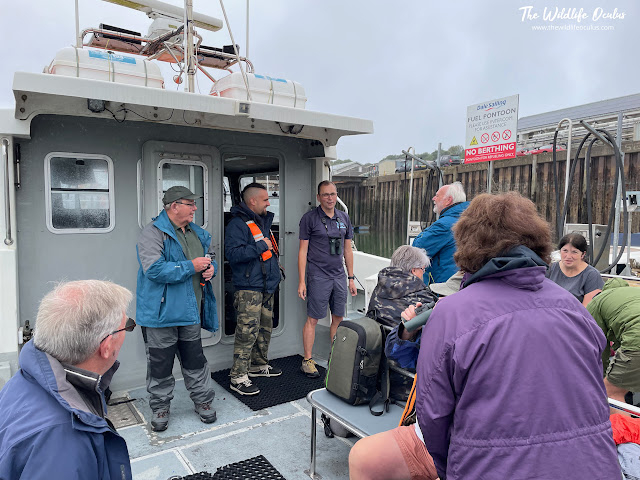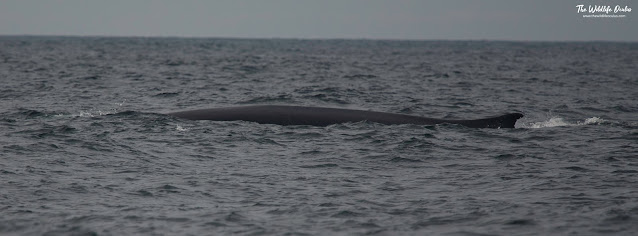 |
| Corys Shearwater |
At 8am on Wednesday 9th of August 2023 the majority of the so called "Goldcliff Gang" congregated at Neyland Marina in order to go on a pelagic boat trip to the Celtic Deep. Paul Coombes had organised the trip earlier this year and it was booked through Dave Astins Western Coast Birdwatching
Dave met us at the marina car park but was unfortunately not able to be the guide. Instead he had a suitable substitute and our guide for the day was the very knowledgeable , experienced and keen eye Clive Hurford.
Our skipper for the day was Alex ( Dale Sailing) and the boat that we would sail on was named the "Helen Clare".
We met up with some of the other passengers and it was fair to say that by 8.30 am we were all brimming over with excitement.
 |
| The boat -"Helen Clare". |
 |
| Looking down at the Helen Clare - our boat for the day (Centre) |
 |
| Getting ready for departure . |
 |
| The Goldcliff Gang |
The engines were powered up and then we were off at quite a great rate of knots.The sea was fairly calm but it was quite misty with a low sea fog . The weather forecast had predicated it should start to lift and brighten up around 11 am.
As we negotiated the harbour and headed out from Neyland we soon had to slow down and stop to watch a Harbour Porpoise. The trip was already starting well.
 |
| Harbour Porpoise |
As we started to make progress towards the Celtic Deeps more Manx Shearwaters appeared forming small rafts of birds and the occasional bird gave us a flypast.
It wasn't very long before we lost sight of the land and we were just surrounded by an open expanse of blue water.
Everyone on the boat was scanning the high seas looking for any sign of birds, cetaceans and anything unusual. There was a large flock of Manx Shearwaters and Clive our guide pointed out a very large Shearwater that looked twice the size of the others. It was a Great Shearwater and something rather unusual. A new lifer for the Goldcliff Gang for sure.
The flock of Shearwaters did not hang around for long and we had time to stop the boat, take some pictures and then they all flew off.
 |
| Great Shearwater ( Center) with a raft of Manx Shearwaters |
 |
| Common Dolphin |

|
A pod of Common Dolphins following the boat ( Image thanks to Phillip Leyshon)
|
On several occasions we were luck enough to spot Common Dolphins and they came so close to the boat you could almost reach out and touch them. At one point they were following the boat in its wake which was absolutely amazing.
The next rarity to be spotted was a big species of Shearwater named a Corys Shearwater that came flying past the boat and disappeared out across the blue expanse.
 |
| Corys Shearwater |
Eventually we reached our destination - a location 43 miles offshore over the Celtic Deep. This part of the Celtic Sea is about 120 meters deep - thats around 300 feet.
The skipper cut the engines and we bobbed about on the sea. Clive and Alex put some chum over the side to attract the birds in. Many seabirds have an excellent sense of smell and the sticky chum should attract them from miles around.
 |
Manx Shearwater
|
One of the most commonest birds we saw apart from the Manx Shearwaters were Storm Petrels. These little petrels are about the size of a Swallow and just look too fragile to be living out in the open sea. They fly quickly over the waves and then swoop down and flitter above the water dabbling their feet into water and daintily picking out small morsels of food from the water.
 |
| European Storm Petrel |
For those with keener eyes amongst us they picked out a Wilsons Petrel. This species looks very similar to the Storm but lacks white markings on the underside of its wings and its legs protrude beyond the tail.
 |
Wilsons Petrel ( Image thanks to Phillip Leyshon)
|
I settled down for five minutes to take a break form scanning the ocean and to have my lunch. Just as I started munching a sandwich I looked up and saw a big dark bird flying directly towards the boat. Clive the guide shouted out "Skua". I grabbed my camera and looked through the view finder - and there its was my first ever Pomarine Skua. This piratical bird then proceeded to do exactly whats in it nature and start mugging a Herring Gull.
The Skua really did make a dramatic entrance and put on a nice show for us before settling down on the water.
 |
| What is that? Its a Pomarine Skua. |
 |
Pomarine Skua harries a Herring Gull
|
 |
| Lesser Black Backed Gulls and a Pom |
 |
| Pomarine Skua |
I was absolutely over the moon as I sure many of my fellow passengers were as seeing a Pomarine Skuas was on my bucket list.
Eventually it was time to move on. We tried another location and stopped for a while , were joined by more Storm Petrels and a few Fulmars that got very close to the boat but things were starting to quiet down a bit. I was in no way disappointed at all and was thoroughly enjoying myself.
 |
| A Fulmar attracting the birder paparazzi. |
 |
| Fulmar headshot |
 |
| Fulmar |
We then started making our way back which was going to result in something rather unexpected and incredibly memorable happening.
As the Helen Clare powered along in a homebound direction suddenly people were shouting out "Whale.... Whales..... WHALES". Alex the skipper slowed the boat and brought us to a stop.
About 500 to 800 meters between our boat and the horizon we could see lots of activity. Seabirds - Manx, Kittiwakes, Storm Petrels, gulls and the odd Gannet were flocking over one area. Underneath them the sea appeared to be boiling over, with what looked like white froth and lots of splashing.
A pod of Dolphins could be seen criss crossing the sea and sometimes porpoising out of the water. Then something huge made a big splash and we saw massive back of a leviathan come up above the waterline and then after what seemed aged a dorsal fin appeared before disappearing under the water.
This whale appeared to be a Fin Whale and there was two of them. A number of the group also saw what we think were Minke Whales.
The Fin Whales were feeding. They would come up turn onto there sides and we could see their gigantic mouths opening to swallow what we think was a bait ball ( a big shoal of fish that get herded by the whales into a ball).
Bait balls often attract many other species of predators who all take advantage of the situation.
 |
| Fin Whale |
 |
| Fluke of a Fin Whales - this photo caused some considerable debate |
The above picture has caused a huge amount of discussion . At first it was suspected to be an Orcas dorsal fin but now after much discussion and review the final conclusion is that it is in fact the tail fluke of a Fin Whale.
 |
| Fin Whale scooping up a bait ball side on |
It was incredible to see Fin Whales off the coast of Wales and we were all so happy to have witnessed a natural event like this. In the above photograph the Fin Whale had just powered into the suspected bait ball side on and you can see its tail fluke, left flipper and the mouth.
 |
| The Fin Whale was turning on its side. |
 |
| Dorsal Fin of the Fin Whale |
My friend Paul Coombes was able to capture some photographs of the Fin Whale from a slightly different angle and you can see its huge mouth closing in on its catch.
 |
| The mouth of a "Fin Whale" ( Image thanks to Paul Coombes) |
 |
| Common Dolphins were also taking part in the feeding frenzy. |
Eventually it was time for us to return to harbour at Neyland. This was one of the best boat trips I have ever been on. All of the "Goldcliff Gang" were beaming from ear to ear , it had been a very successful Pelagic Trip by all accounts.
Many thanks to the skipper Alex (Dale Sailing) for keeping us safe and getting us there and back again. Big shout out to Clive Hurford our guide who's keen eyes and knowledge was a great help and thanks to Dave Astins and West Coast Birdwatching, we really did witness some pelagic magic - awesome day.
Lastly huge thank you to Paul Coombes for arranging and inviting the "Goldcliff Gang" along.
Species List
( Main Species highlights)
- Fulmar
- Manx Shearwater
- European Storm Petrel
- Wilsons Storm Petrel
- Gannet
- Pomarine Skua
- Kittiwake
- Lesser Backed Gull
- Greater Black Backed Gull
- Arctic Tern
- Common tern
- Guillimot
- Razorbill
- Harbour Porpoise
- Common Dolphin
- Minke Whale
- Fin Whale
- Atlantic Grey Seal
- Jelly Fish.





























Comments
Post a Comment